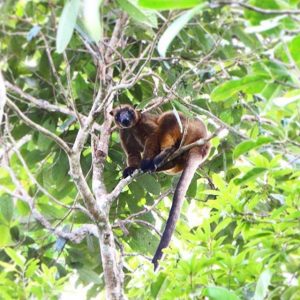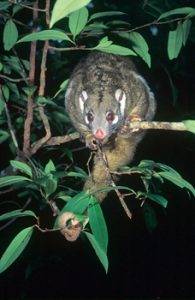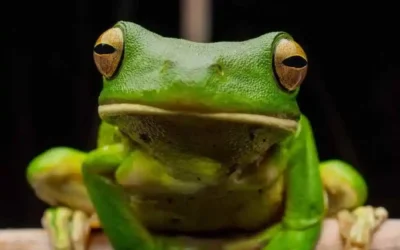Hairy Rainforest Animals
Rainforest animals use their hair for protection, camouflage & navigation.
Unlike rainforest animals, some humans spend a considerable amount of time and money grooming their hair. Whether they are straightening, curling, cutting growing or removing, yet we still don’t give too much consideration to its role and occurrence in nature.
As mammals, we have hair all over us, but we are not alone. Insects, spiders, plants, earthworms and even frogs can have hairs or hair like structures. So why all of the hair?

An obvious answer for us is to help keep us warm, but reasons are varied from species to species. Hair for us and many creatures also helps to protect our skin, if groomed it can assist in attracting a mate or for social reasons, can be a statement of how we think or feel and can be an indicator of our age or status.
I recently saw two Tree-Kangaroos near Skyrail’s Red Peak Station, eight days apart. The first was a large male with dark, dull fur (pictured) while the second was a juvenile only half the size of the previous Kangaroo with more bright and glossy fur. These animals also use their fur to keep themselves camouflaged in the canopy and to keep the water off their skin when it rains.
Spiders use hair for a number of reasons. The big hairy spiders that many people don’t enjoy seeing, such as Barking spiders, use their thick hair for defence. I once worked in Costa Rica’s rainforest where the local tarantulas can be annoying, not for their bite, but the way they brush their legs together to get the itchy hairs onto your skin. Coatis (long nosed relatives of the Raccoon) catch them and rub them in the dirt to remove a lot of their hair before eating them.
Small birds cannot easy purge hair from their digestive system like the pellets of bones, feathers, hair and claws that are regurgitated by owls and other raptors. This is one of the main reasons caterpillars often have hairs, the so called “Hairy Bears.”
Water spiders and diving beetles use their hairs to trap a layer of air to breathe while they are underwater, similar to the tank of a scuba diver. Setae, the hairs on the feet of geckos, enables them to walk upside down on ceilings, up glass windows and stick to glossy leaves of rainforest trees.
Colour is another use for hairs, whether it be the grey green mixtures of different hairs of the green ring-tailed possum of the local rainforest (seen recently at Red Peak Station) to give them the characteristic camouflaging in the canopy, or the bright golden orange coat of the Golden Lion Tamarin of Brazil’s rainforests. Many mammals, especially those which are nocturnal, have whiskers to help navigate around obstacles at night. Many years ago I helped research Feather-tailed gliders, tiny possums that use rows of stiff hairs either side of the tail to act as a rudder to steer the animal during gliding between trees.

Ever noticed that that stepping on a cockroach can be more difficult than you first think? Cockroaches have hairs to detect air pressure and movement and are so sensitive that they can tell when the “bow wave” of air is approaching them from your foot. In your inner ear, stereocilia respond to fluid motion, as they do in numerous types of animals for various functions, including hearing and balance and are the organelles of hair cells.
Earth worms use setae hairs to get a grip under the ground, the large ones in the local Cairns rainforest are quite strong and you can feel them if you pick them up. Hair also absorbs or diffuses light, helping rainforest animals to look “softer“ and absorb any harsh lines or shadows, this way they blend into the rainforest.
Plants leaves are often covered in hairs to protect them from drying out or being eaten by insects, peaches have fluffy hair for the same reason and local rainforest bush tucker plant, Davidson Plum, has strong hairs making the tasty fruit spikey until washed. Even Hairy frogs from Central African rainforest have hair like projections to assist with breathing underwater, a bit like gills.
On a project I once built hair tubes, traps lined with double sided tape to catch not animals but their hairs as they sniff baits. Animal hair is so distinct at a microscopic level it is often used to determine species for monitoring and research, and animals don’t have to be live trapped or held.
Australian Rainforest Facts by Skyrail Ranger Lance Neville




